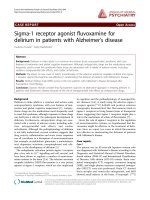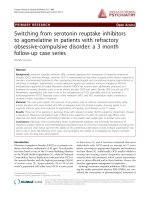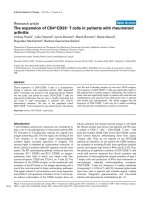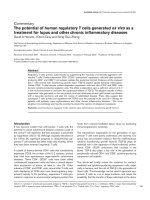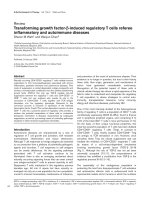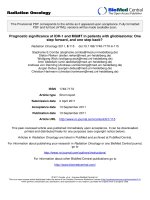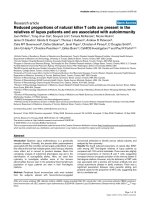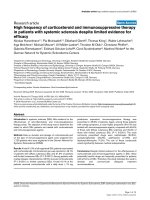Báo cáo y học: "The expansion of CD4+CD28– T cells in patients with rheumatoid arthritis" potx
Bạn đang xem bản rút gọn của tài liệu. Xem và tải ngay bản đầy đủ của tài liệu tại đây (52.82 KB, 4 trang )
R210
Introduction
T-cell-mediated autoimmune responses are considered to
play a role in the pathogenesis of rheumatoid arthritis (RA)
[1]. Activation of T lymphocytes requires two signals from
antigen-presenting cells. The first signal, the binding of the
T-cell receptor to its antigen major histocompatibility
complex ligand, provides specificity of antigens. The
second signal is mediated by costimulatory molecules, of
which a family of proteins called B7 appears to be the most
potent. The B7 costimulatory pathway involves at least two
molecules, B7-1 (CD80) and B7-2 (CD86), on antigen-
presenting cells, both of which can interact with their
counter-receptors, CD28 and CTLA-4, on T cells [2]. The
interaction of the CD28 receptor on the lymphocyte with
receptors of the B7 family on the antigen-presenting cell is
one of the most important of these costimulatory pathways.
This signal induces T-cell activations and clonal expansion
and inhibits T-cell apoptosis. Activation of the T-cell recep-
tor without costimulation of the CD28 receptor does not
induce activation but instead induces anergy or cell death
[3]. Recent studies have shown that patients with RA carry
a subset of CD4
+
T cells – CD4
+
CD28
–
T cells – that
lacks the receptor CD28. Cells of this CD4
+
CD28
–
subset
have several features differentiating them from classic
T helper cells. They do not depend on the B7/CD28
pathway for activation, do not express the CD80 receptor,
are incapable of activating B cells, have significant cytolytic
activity, and express high levels of IFN-γ and IL-2 [4]. Thus,
the presence of significant numbers of CD4
+
CD28
–
T cells
could shift immune response from B-cell activation and
production of immunoglobulins toward activation of type-1
T helper cells and production of IFN-γ and involvement of
macrophages releasing matrix-degrading proteases.
CD4
+
CD28
–
T cells are infrequent in healthy individuals
(comprising 0.1–2.5% of T cells) [5], whereas higher levels
have been seen in patients with unstable angina, multiple
sclerosis, Wegener’s granulomatosis, and rheumatoid
arthritis with extra-articular manifestations [6–11].
FACS = fluorescence-activated cell sorting; FITC = fluorescein isothiocyanate; IFN = interferon; IL = interleukin; KIR = killer inhibitory receptor;
MHC = major histocompatibility antigen; NK = natural killer (cells); PE = phycoerythrin; RA = rheumatoid arthritis.
Arthritis Research & Therapy Vol 5 No 4 Pawlik et al.
Research article
The expansion of CD4
+
CD28
–
T cells in patients with rheumatoid
arthritis
Andrzej Pawlik
1
, Lidia Ostanek
2
, Iwona Brzosko
2
, Marek Brzosko
2
, Marek Masiuk
3
,
Boguslaw Machalinski
3
, Barbara Gawronska-Szklarz
1
1
Department of Pharmacokinetics and Therapeutic Drug Monitoring, Pomeranian University of Medicine, Szczecin, Poland
2
Department of Rheumatology, Pomeranian University of Medicine, Szczecin, Poland
3
Department of Pathology, Pomeranian University of Medicine, Szczecin, Poland
Corresponding author: Andrzej Pawlik (e mail: pawand@poczta. onet.pl)
Received: 20 Dec 2002 Revisions requested: 5 Feb 2003 Revisions received: 26 Feb 2003 Accepted: 8 Apr 2003 Published: 14 May 2003
Arthritis Res Ther 2003, 5:R210-R213 (DOI 10.1186/ar766)
© 2003 Pawlik et al., licensee BioMed Central Ltd (Print ISSN 1478-6354; Online ISSN 1478-6362). This is an Open Access article: verbatim
copying and redistribution of this article are permitted in all media for any purpose, provided this notice is preserved along with the article's original
URL.
Abstract
Clonal expansion of CD4
+
CD28
–
T cells is a characteristic
finding in patients with rheumatoid arthritis (RA). Expanded
CD4
+
clonotypes are present in the peripheral blood, infiltrate
into the joints, and persist for years. CD4
+
CD28
–
T cells are
oligoclonal lymphocytes that are rare in healthy individuals but
are found in high percentages in patients with chronic
inflammatory diseases. The size of the peripheral blood
CD4
+
CD28
–
T-cell compartment was determined in 42 patients
with RA and 24 healthy subjects by two-color FACS analysis.
The frequency of CD4
+
CD28
–
T cells was significantly higher in
RA patients than in healthy subjects. Additionally, the number of
these cells was significantly higher in patients with extra-articular
manifestations and advanced joint destruction than in patients
with limited joint manifestations. The results suggest that the
frequency of CD4
+
CD28
–
T cells may be a marker correlating
with extra-articular manifestations and joint involvement.
Keywords: arthritis, CD4
+
CD28
–
, lymphocytes
Open Access
Available online />R211
In the present study we evaluated the correlation between
the CD4
+
CD28
–
T-cell subset and extra-articular manifes-
tations, magnitude of joint involvement, and presence of
rheumatoid factor.
Material and methods
Patients
Forty-two patients (26 women, 16 men, age 24–74 years,
mean 51.7 years) with rheumatoid arthritis diagnosed
according to the criteria of the American College of
Rheumatology were included in the study. The disease
duration was 4–19 years (mean 12.8 years). Patients were
recruited from the outpatient and inpatient population of
the Department of Rheumatology, University Hospital,
Szczecin, Poland. All subjects were white and were from
the Pomeranian region of Poland.
The subjects underwent routine biochemical blood analy-
sis, and anticardiolipin antibodies and antinuclear antibod-
ies were determined if this was required. In all patients,
X-rays were made of the chest, hands, feet, and, when
required, other joints. The evaluation of the subjects
included physical examinations with attention to pattern of
joint involvement, presence of nodules, and other extra-
articular features such as vasculitis, anemia, sicca syn-
drome, amyloidosis, organ involvement, and laboratory
features such as erythrocyte sedimentation rate and
rheumatoid factor. To examine whether the presence of
large numbers of CD4
+
CD28
–
T cells in patients with RA
is predictive of disease manifestation, the patients were
allocated according to their disease pattern, as follows:
group 1, RA limited to joints (10 subjects); group 2,
advanced joint involvement (12 subjects); and group 3,
extra-articular manifestations (20 subjects).
Group 1, patients with RA limited to joints (n = 10; mean
age 52.5 years, mean disease duration 12.2 years),
included patients with fewer than six swollen joints and
without extra-articular manifestations. Six of these had joint
erosions and four did not. The time between diagnosis of
RA and the occurrence of joint erosions was more than
2 years (mean 4.8 years).
Group 2, patients with advanced joint manifestations
(n = 12; mean age 51.4 years, mean disease duration
13.4 years), included patients each with more than six
swollen joints and with radiologically diagnosed erosions
(in all the patients), without subcutaneous nodulosis or
extra-articular manifestations. The time between diagnosis
of disease and the occurrence of joint erosions was less
than 2 years (mean 1.4 years).
Group 3, patients with extra-articular manifestations
(n = 20; mean age 51.5 years, mean disease duration
12.7 years), included 8 patients with nodulosis, 4 with
anemia and nodules, 1 with vasculitis and nodules, 4 with
vasculitis only, 1 with vasculitis and amyloidosis, and 2
with sicca syndrome and amyloidosis. Amyloidosis was
diagnosed by histomorphology (in biopsy specimens from
skin and bowel or duodenum), and vasculitis, by histo-
morphology (skin biopsy) and angiogram. All the patients
in this group had joint erosions.
The control group consisted of 24 healthy subjects
(14 women and 10 men, age 22–70 years, mean age
48.7 years). The study was approved by the local ethics
committee and written informed consent was obtained
from all subjects.
Statistical analysis
CD4
+
CD28
–
T cells in the groups studied were compared
by use of the Mann–Whitney U test, because of non-
normal distribution of the results. The frequencies of
CD4
+
CD28
–
T cells were expressed as median percent-
ages of total lymphocytes. Relations between parameters
were analyzed using a linear correlation test.
Flow cytometry
Peripheral blood mononuclear cells were obtained by Ficoll
gradient centrifugation. The cells (300,000–500,000)
were stained with fluorescein isothiocyanate (FITC)-conju-
gated anti-CD4 and phycoerythrin (PE)-conjugated anti-
CD28 monoclonal antibodies (Becton Dickinson, San
Jose, CA, USA). FITC-conjugated IgG1 and PE-conjugated
IgG2a (Becton Dickinson) and FITC-conjugated anti-CD4
and PE-conjugated anti-CD3 (Becton Dickinson) were
used as negative and positive controls, respectively. Flow
cytometry was performed on a FACS-Calibur (Becton
Dickinson) and the results were analyzed with PC-lysis
software (Becton Dickinson). The fraction of cells within
the CD4
+
population that was CD28
–
was calculated by
gating on the CD4
+
CD28
+
and CD4
+
CD28
–
populations.
Results
Absolute lymphocyte numbers in patients with RA and
controls were not different. The median frequency of
CD4
+
CD28
–
T cells was 1.40% in the healthy control
population and 7.86% in patients with RA (P < 0.001).
A loss of CD28 expression in the elderly has been
described. Therefore we evaluated the correlation
between subjects’ ages and the number of CD28
–
T cells.
No correlation was found for RA patients (r = 0.09,
P = 0.7). There was a slight but not statistically significant
correlation for control subjects (r = 0.25, P = 0.1).
The number of CD4
+
CD28
–
T cells in each of these
disease categories is shown in Table 1. The frequency of
CD4
+
CD28
–
T cells was 4.82% in patients with limited
joint manifestations, 7.05% in those with advanced joint
involvement, and 10.35% in those with extra-articular man-
ifestations.
Arthritis Research & Therapy Vol 5 No 4 Pawlik et al.
R212
The frequency of CD4
+
CD28
–
T cells in groups 2 and 3
differed significantly from that in group 1 (see Table 1).
To investigate the relation between the amount of CD28
–
T cell and disease chronicity, a correlation between cell
frequencies and disease duration was sought; none was
found (r = 0.14, P = 0.3). The size of the CD4
+
CD28
–
T-cell compartment was not determined by the duration of
the inflammatory process.
The relation between the presence of rheumatoid factor
and the frequency of the CD4
+
CD28
–
lymphocytes was
evaluated. A higher frequency of these cells in patients
with seronegative (median value 8.17%) than with
seropositive (median value 6.53%) RA was observed;
however, this difference was not statistically significant
(P = 0. 062).
Discussion
In this study, the CD4
+
CD28
–
T-cell frequency in patients
with RA and healthy subjects was evaluated. The fre-
quency of CD4
+
CD28
–
T lymphocytes in the control
group was similar to the frequencies found by other inves-
tigators. Among RA patients, the frequency of these lym-
phocytes was significantly higher then in the controls.
Nevertheless, the CD4
+
CD28
–
T-cell compartment dif-
fered depending on extra-articular manifestations and joint
involvement. The lowest frequency of CD4
+
CD28
–
T cells
was in RA patients with limited joint manifestations. Signif-
icantly higher numbers of CD28
–
lymphocytes were
present in patients with advanced joint involvement and
extra-articular manifestations.
The association of CD4
+
CD28
–
T cells with disease
status has given rise to the hypothesis that these cells
directly contribute to disease manifestations. Patients with
nodulosis and extra-articular manifestations of RA have
grossly expanded populations of CD4
+
CD28
–
T cells [9].
In patients with coronary artery disease, the frequency of
these cells correlates with the risk of acute coronary syn-
dromes [6]. Such syndromes develop if the atheroscle-
rotic plaque is inflamed and develops a fissure or ulcera-
tion, with subsequent thrombosis. Clonal expansion of
CD4
+
CD28
–
T cells has been found in the inflamed
plaque of such patients [12].
The lack of CD28 expression on CD4
+
T cells is a very
unusual feature for the mature CD4 T cell. T-cell function
has been intimately linked to the CD28 molecule. Thus
clonally expanded T cells in RA patients are characterized
not only by abnormal growth behavior but also by unusual
functional properties. The presence of large numbers of
these T cells in RA patients is likely to influence immune
responsiveness and alter mechanisms of inflammation,
which depend on T-cell regulation. In contrast with classic
T cells, CD4
+
CD28
–
T cells produce a high amount of IFN
in the absence of costimulatory pathway [10,13]. The
expansion of this cell population is genetically determined.
CD28 deficiency is due to a transcriptional block resulting
from the loss of nuclear transcription factors binding to
two distinct regulatory motifs in the promoter region of the
CD28 gene [14]. The repression of CD28 transcription
may be also the consequence of chronic exposure to TNF-
α, which leads to the blocking of CD28 transcription [15].
Despite the loss of the CD28 molecule, these CD4
+
T cells are functionally active and have the ability to
release cytokines in the absence of a costimulatory
pathway.
CD4
+
CD28
–
T cells contribute to the cell infiltrate and
exhibit increased survival after apoptotic stimuli. Resis-
tance to apoptosis in CD28
–
T cells is due to elevated
expression of antiapoptotic protein Bcl-2 and Fas-associ-
ated with death domain-like IL-1-converting enzyme
inhibitory protein (FLIP) [16]. The absence of CTLA4
surface expression on CD28
–
T cells may also play a role
in their prolonged proliferative response and resistance to
activation-induced cell death.
Moreover, these cells are characterized by intracellular
storage of the cytolytic proteins perforin and granzyme B
and are functionally specialized for cytotoxic activity [17].
Perforin was found in CD4
+
CD28
–
peripheral blood lym-
phocytes, and CD4
+
perforin-positive T cells were present
in the synovial tissue, where their frequency correlated
with the expansion of the CD4
+
CD28
–
T-cell compart-
ment in the periphery [10].
CD4
+
CD28
–
T cells have several characteristics of natural
killer (NK) cells, including the cell-surface expression of
regulatory killer activating and inhibitory receptors, CD8αα
homodimers, and molecule 161, which enhance their
ability to infiltrate tissue [17,18]. The presence of CD8αα
homodimers as well as regulatory killer activating and
inhibitory receptors on CD28
–
T cells suggests that the
functional properties of these cells are under the control of
Table 1
Frequency of CD4+CD28
–
T cells in control group and in
patients with RA
Subjects CD4
+
CD28
–
T cells (%)
a
P
Control group 1.40 (0.1–3.4)
Groups of RA patients
1) With limited joint manifestations 4.82 (3.71–10.95 0.001
b
2) With advanced joint involvement 7.05 (4.43–20.04) 0.005
c
3) With extra-articular manifestations 10.35 (4.19–36.60) 0.001
c
a
Median (range).
b
vs control group.
c
vs RA patients with limited joint
manifestations.
Available online />R213
MHC class I molecules. The expansion and activation of
these cells in RA may therefore reflect a coordinated
action of MHC-class-II- and MHC-class-I-mediated stimu-
lation of T-cell receptors and killer inhibitory receptors
(KIRs), respectively [19]. The gene for the killer-cell
immunoglobulin-like receptor KIR2DS2 was found to be a
genetic risk factor of vasculitis manifestations in patients
with RA [20].
The accumulation of NK-receptors expressing CD4 cells
in synovial tissue is compatible with a direct contribution
of these cells to the tissue lesions [17].
Our results confirm previous reports that the role of
CD4
+
CD28
–
T cells in RA pathogenesis may be related to
their cytotoxic capability, which may contribute to extra-
articular manifestations. The higher frequency of these
cells in patients with severe joint involvement and rapid
joint progression confirm observations that the frequency
of CD4
+
CD28
–
T cells may correlate with the risk of
occurrence of joint erosions in RA [18].
Competing interests
None declared.
References
1. Reveille JD: The genetic contribution to the pathogenesis of
rheumatoid arthritis. Curr Opin Rheumatol 1998, 10:187-200.
2. Janeway CA Jr, Bottomly K: Signals and signs for lymphocyte
responses. Cell 1994, 76:275-285.
3. Linsley PS, Ledbetter JA: The role of the CD 28 receptor during
T cell responses to antigen. Annu Rev Immunol 1993, 11:191-
212.
4. Park W, Weyand CM, Schmidt D, Goronzy JJ: Co-stimulatory
pathways controlling activation and peripheral tolerance of
human CD4+CD28- T cells. Eur J Immunol 1997, 27:1082-
1090.
5. Morishita Y, Sao H, Hansen JA, Martin PJ: A distinct subset of
human CD4+ cells with a limited alloreactive T cell receptor
repertoire. J Immunol 1989, 143:2783-2789.
6. Liuzzo G, Goronzy JJ, Yang H, Kopecky SL, Holmes DR, Frye RL,
Weyand CM: Monoclonal T-cell proliferation and plaque insta-
bility in acute coronary syndromes. Circulation 2000, 101:
2883-2888.
7. Markovic-Plese S, Cortese I, Wandinger KP, McFarland HF, Marti
R: CD4+CD28- costimulation-independent T cells in multiple
sclerosis. J Clin Invest 2001, 108:1185-1194.
8. Lamprecht P, Moosig F, Csernok E, Seitzer U, Schnabel A,
Mueller A, Gross WL: CD28 negative T cells are enriched in
granulomatous lesions the respiratory tract in Wegener’s
granulomatosis. Thorax 2001, 56:751-757.
9. Martens PB, Goronzy JJ, Schaid D, Weyand CM: Expansion of
unusual CD4+T cells in severe rheumatoid arthritis. Arthritis
Rheum 1997, 40:1106-1114.
10. Namekawa T, Wagner UG, Goronzy JJ, Weyand CM: Functional
subsets of CD4 T cells in rheumatoid synovitis. Arthritis
Rheum 1998, 41:2108-2116.
11. Schmidt D, Martens PB, Weyand CM, Goronzy JJ: The repertoire
of CD4+ CD28-T cells in rheumatoid arthritis. Mol Med 1996,
2:608-618.
12. Nakajima T, Schulte S, Warrington KJ, Kopecky SL, Frye RL,
Goronzy JJ, Weyand CM: T-cell mediated lysis of endothelial
cells in acute coronary syndromes. Circulation 2002, 105:570-
575.
13. Schmidt D, Goronzy JJ, Weyand CM: CD4+CD7-CD28- T cells
are expanded in rheumatoid arthritis and are characterized by
autoreactivity. J Clin Invest 1996, 97:2027-2037.
14. Vallejo AN, Weyand CM, Goronzy JJ: Functional disruption of
the CD28 gene transcriptional initiator in senescent T cells. J
Biol Chem 2001, 276:2565-2570.
15. Bryl E, Vallejo AN, Weyand CM, Goronzy JJ: Down-regulation of
CD28 expression by TNF-alpha. J Immunol 2001, 167:3231-
3238.
16. Schirmer M, Vallejo AN, Weyand CM, Goronzy JJ: Resistance to
apoptosis and elevated expression of Bcl-2 in clonally
expanded CD4+CD28- T cells from rheumatoid arthritis
patients. J Immunol 1998, 161:1018-1025.
17. Warrington KJ, Takemura S, Goronzy JJ, Weyand CM:
CD4+CD28- T cells in rheumatoid arthritis patients combine
features of the innate and adaptive immune systems. Arthritis
Rheum 2001, 44:13-20.
18. Snyder MR, Muegge LO, Offord C, O’Fallon WM, Bajzer Z,
Weyand CM, Goronzy JJ: Formation of the killer Ig-like recep-
tor on CD4+CD28 null T cells. J Immunol 2002, 168:3839-
3846.
19. Yen JH, Moore BE, Nakajima T, Scholl D, Schaid DJ, Weyand CM:
Major histocompatibility complex class I-recognizing recep-
tors are disease risk genes in rheumatoid arthritis. J Exp Med
2001, 193:1159-1167.
20. Nemekawa T, Snyder MR, Yen JH, Goehring BE, Leibson PJ,
Weyand CM, Goronzy JJ: Killer cell activating receptors func-
tion as costimulatory molecules on CD4+CD28 null T cells
clonally expanded in rheumatoid arthritis. J Immunol 200, 165:
1138-1145.
Correspondence
Andrzej Pawlik, Department of Pharmacokinetics and Therapeutic Drug
Monitoring, Pomeranian University of Medicine, 70-111 Szczecin, ul.
Powstancow Wlkp. 72, Poland. Tel and fax: +48 91 4661600; e mail
pawand@poczta. onet.pl

